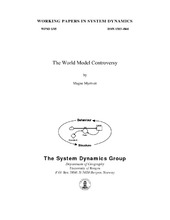The World Model Controversy
Working paper
Permanent lenke
https://hdl.handle.net/1956/1974Utgivelsesdato
2005Metadata
Vis full innførselSamlinger
- Department of Geography [634]
Sammendrag
In 1971 Jay Forrester published his book World Dynamics, where he presented a high-levelsimulation model of the socio-economic-environmental world system. The main purpose ofthe model and the accompanying book was to encourage an open debate about the long-termfuture on our planet. The World Model was created in a time where pollution and othernegative effects of industrialization and economic growth started to become recognized.Forrester made the assumption that life on earth is bounded within certain limits, such asavailable space and resources. Based on this he concluded that exponential economic growthcannot continue forever; sooner or later one or more limits will be reached. The question,then, is how mankind can manage its own future in ways that can avoid an unpleasantencounter with the limits to growth. The Club of Rome, a non-profit research organization,appointed Dennis Meadows, Donella Meadows and others to elaborate on the work initiatedby Forrester. The resulting report, Limits to Growth, became a bestseller almost over night.Large parts of the established economic community reacted with massive criticism towardsthe limits to growth ideas, and characterized the work as dooms day prophecies with no basisin observed data and established theories. In this essay I describe System Dynamics andeconometrics; the scientific home bases of the two sides in the controversy. Based on atheoretical framework developed by Ernan McMullin, I try to categorize the issues that werediscussed in the context of the World Model. My findings are that the World Model debate isa mixed controversy, involving different views on facts, theories, principles and values. Thecontroversy has evolved over three decades, and has not ended. The main questions are stillrelevant and subject to discussion among scientists, politicians, environmentalists, andordinary people.
